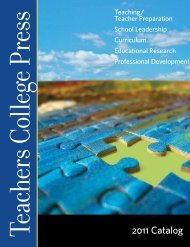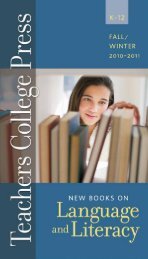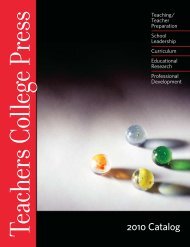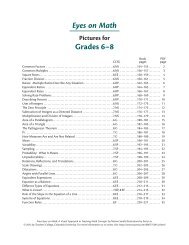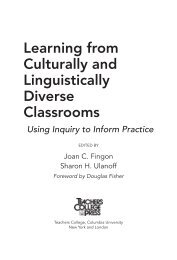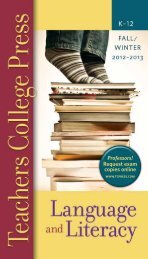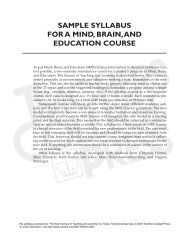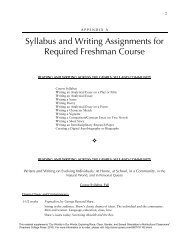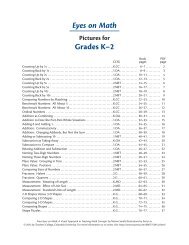Spectacular Things Happen Along the Way - Teachers College Press
Spectacular Things Happen Along the Way - Teachers College Press
Spectacular Things Happen Along the Way - Teachers College Press
Create successful ePaper yourself
Turn your PDF publications into a flip-book with our unique Google optimized e-Paper software.
Responding to<br />
Brian D. Schultz’s <strong>Spectacular</strong> <strong>Things</strong> <strong>Happen</strong> <strong>Along</strong> <strong>the</strong> <strong>Way</strong>:<br />
Lessons from an Urban Classroom<br />
-A Guide for Reflection and Action-<br />
by Shira Eve Epstein<br />
<strong>Spectacular</strong> <strong>Things</strong> <strong>Happen</strong> <strong>Along</strong> The <strong>Way</strong> promotes a vibrant vision of teaching for<br />
social change from <strong>the</strong> perspective of a fifth-grade teacher in Chicago’s Cabrini Green<br />
neighborhood. Over <strong>the</strong> course of one school year, <strong>the</strong> students in Room 405 developed<br />
a sophisticated advocacy plan calling for a new school building, as <strong>the</strong>irs suffered from<br />
<strong>the</strong> structural inadequacies facing many urban schools. The classrooms were cold,<br />
windows cracked, and <strong>the</strong>y had nei<strong>the</strong>r an auditorium nor lunchroom for use. Brian<br />
Schultz, <strong>the</strong>ir teacher and author of <strong>the</strong> book, enacted a social action project with <strong>the</strong> fifth<br />
graders to address to <strong>the</strong>ir obvious concerns. While a new school was never built, we<br />
learn how Schultz and <strong>the</strong> students gained much media attention, built a base of<br />
supporters (including Ralph Nader) and developed activist skills—all while successfully<br />
meeting subject-specific state standards. The fifth graders questioned <strong>the</strong> status quo and<br />
made a durable impact on <strong>the</strong>ir community. They stand as role models for elementary<br />
and middle school–aged students as well as adults. Students in universities, practicing<br />
teachers, and youth workers in community-based organizations can turn to <strong>Spectacular</strong><br />
<strong>Things</strong> <strong>Happen</strong> <strong>Along</strong> <strong>the</strong> <strong>Way</strong> for a reminder of what is possible.<br />
Such narratives are particularly notable in our era of accountability. The rigidity of<br />
testing calendars and scripted curricula limits <strong>the</strong> likelihood of <strong>the</strong> enactment of social<br />
action projects. <strong>Teachers</strong> may feel that <strong>the</strong> pressure to meet <strong>the</strong> standards and prepare<br />
students for high-stakes tests leaves no room for <strong>the</strong>m to develop projects that address<br />
relevant issues or lead to social change. While Schultz acknowledges this pressure,<br />
<strong>Spectacular</strong> <strong>Things</strong> <strong>Happen</strong> <strong>Along</strong> <strong>the</strong> <strong>Way</strong> shows how students can simultaneously<br />
develop activist and standards-oriented academic skills. Standards-based teaching does<br />
not need to be pitted against social action. For example, <strong>the</strong> fifth graders exercised math<br />
skills when <strong>the</strong>y collected and analyzed quantitative data on <strong>the</strong> school conditions. They<br />
This Guide accompanies “<strong>Spectacular</strong> <strong>Things</strong> <strong>Happen</strong> <strong>Along</strong> <strong>the</strong> <strong>Way</strong>” (<strong>Teachers</strong> <strong>College</strong> <strong>Press</strong>: 2008).<br />
For more information or to order, please visit: http://store.tcpress.com/0807748579.shtml
developed <strong>the</strong>ir English language arts skills as <strong>the</strong>y created documents (e.g., petitions and<br />
letters) to raise public awareness about <strong>the</strong> school’s conditions, and <strong>the</strong>y read books and<br />
articles to help <strong>the</strong>m place <strong>the</strong>ir campaign within a broader context.<br />
Multiple audiences can reflect on Schultz’s vision and <strong>the</strong> teaching practices that<br />
sustained it. <strong>Spectacular</strong> <strong>Things</strong> <strong>Happen</strong> <strong>Along</strong> <strong>the</strong> <strong>Way</strong> would serve a generative role in<br />
an education foundations class during discussions about <strong>the</strong> purposes of public education;<br />
a teacher education program to portray student-centered instruction; and a professional<br />
development class for educators or community-based organizations to provide a model of<br />
a youth participation in <strong>the</strong> community. Much of this guide is geared to <strong>the</strong>se audiences.<br />
At <strong>the</strong> end of <strong>the</strong> guide, <strong>the</strong>re is a section on using this text as a means to generate<br />
conversations about broad trends in American schooling and research methods among<br />
master’s and doctoral students, as well as o<strong>the</strong>rs.<br />
Given <strong>the</strong> narrative style of <strong>the</strong> text, I suggest that readers complete <strong>Spectacular</strong> <strong>Things</strong><br />
<strong>Happen</strong> <strong>Along</strong> <strong>the</strong> <strong>Way</strong> and <strong>the</strong>n view <strong>the</strong> story holistically as <strong>the</strong>y reflect on it. Below, I<br />
propose activities, prompts, and projects that can be introduced in reference to five<br />
<strong>the</strong>mes: understanding social action; enacting social action curriculum; placing student<br />
voices at <strong>the</strong> center of <strong>the</strong> curriculum; developing <strong>the</strong> habits of reflective practitioners;<br />
and studying classrooms in action. Each <strong>the</strong>me is accompanied by a focus question to<br />
direct <strong>the</strong> readers, and <strong>the</strong> language of <strong>the</strong> text is intended to speak directly to <strong>the</strong>m. The<br />
uplifting nature of <strong>the</strong> story positions it as a catalyst of change. This guide is meant to be<br />
an aid in this effort.<br />
Understanding Social Action<br />
<strong>Spectacular</strong> <strong>Things</strong> <strong>Happen</strong> <strong>Along</strong> <strong>the</strong> <strong>Way</strong> can help us study <strong>the</strong> markers of social action<br />
curriculum and view it in reference to o<strong>the</strong>r educational debates, concepts in educational<br />
research, and our own stories. The activities below will aid you in such analytic and<br />
reflective work. This section may be particularly helpful to undergraduate students<br />
exploring <strong>the</strong> purposes of schooling and those unfamiliar to social action curriculum in<br />
general.<br />
Focus Question: What are <strong>the</strong> possibilities for social action curriculum in K–12 schools?<br />
1. List everything that was “striking” or notable about <strong>the</strong> social action curriculum in<br />
Room 405. Work in small groups to explain why you chose <strong>the</strong> elements that you<br />
did and how <strong>the</strong>se elements might impact K –12 students.<br />
2. Create a visual diagram, or a concept map, showing how different components of<br />
<strong>the</strong> curriculum are related. You may want to begin by writing down various<br />
issues that drove <strong>the</strong> project on post-it notes. These could include: substandard<br />
school building; student concerns; and Schultz’s student-centered teaching<br />
philosophy. Then, arrange <strong>the</strong> post-it notes on a large sheet of paper showing<br />
<strong>the</strong>ir relationships with each o<strong>the</strong>r. To guide this activity, consider <strong>the</strong> following<br />
This Guide accompanies “<strong>Spectacular</strong> <strong>Things</strong> <strong>Happen</strong> <strong>Along</strong> <strong>the</strong> <strong>Way</strong>” (<strong>Teachers</strong> <strong>College</strong> <strong>Press</strong>: 2008).<br />
For more information or to order, please visit: http://store.tcpress.com/0807748579.shtml
questions: Which issues were at <strong>the</strong> center of <strong>the</strong> curriculum and which were at<br />
<strong>the</strong> periphery? Which issues contributed to each o<strong>the</strong>r?<br />
3. Compare this social action project with o<strong>the</strong>r efforts to teach about and for social<br />
justice reviewed in educational scholarship. For example, some justice-oriented<br />
projects are based around <strong>the</strong> needs of o<strong>the</strong>rs (i.e., students learn about and take<br />
action around people’s life experiences unlike <strong>the</strong>ir own). O<strong>the</strong>r projects, such as<br />
<strong>the</strong> one in Room 405, ask students to address issues in <strong>the</strong>ir own lives. Walter<br />
Parker’s Teaching Democracy (2003) and Rahima Wade’s Social studies for<br />
social justice (2007), might be helpful here as <strong>the</strong>se texts describe teachers and<br />
students working towards democracy and social justice in K–12 schools. After<br />
you have identified a series of comparisons, discuss <strong>the</strong>ir implications. What are<br />
<strong>the</strong> possibilities and limitations of different projects?<br />
4. Discuss <strong>the</strong> role of race and class in <strong>the</strong> book. Some questions to guide your<br />
conversation may include: How might <strong>the</strong> project have evolved if Schultz asked a<br />
class of white students to evaluate <strong>the</strong> problems in <strong>the</strong>ir community? More<br />
broadly, how does race, class, gender, sexual orientation, or learning ability affect<br />
students as <strong>the</strong>y enact social action projects? Jaris (a student in Room 405)<br />
thought that <strong>the</strong> students’ not getting a new school had something to do with<br />
“blackness” (p. 38). Consider using this insight to prompt discussion.<br />
5. Read a book on urban poverty or urban schooling as a co-text so to create a<br />
sociohistorical backdrop for <strong>Spectacular</strong> <strong>Things</strong> <strong>Happen</strong> <strong>Along</strong> <strong>the</strong> <strong>Way</strong>. You<br />
may consider Jonathan Kozol’s Savage Inequalities (1991), as this is what <strong>the</strong><br />
students in Room 405 read when building an understanding of <strong>the</strong>ir own<br />
experience. Also, Pauline Lipman’s High stakes education (2007) analyzes<br />
several schools in Chicago, and <strong>the</strong>refore offers a place-specific framing of <strong>the</strong><br />
story of Schultz and <strong>the</strong> fifth graders. Write about or discuss <strong>the</strong> role of social<br />
action projects given <strong>the</strong> realities presented in <strong>the</strong>se texts.<br />
6. Discuss <strong>the</strong> work of <strong>the</strong> fifth graders in light of an analytic framework that<br />
illustrates <strong>the</strong> possibilities of civic education. For example, Wes<strong>the</strong>imer and<br />
Kahne’s What Kind of Citizen? The Politics of Educating for Democracy (2004)<br />
outlines different kinds of citizens:<br />
i. a “personally responsible citizen acts responsibly in his or her<br />
community” by engaging in service work such as recycling<br />
ii. a “participatory citizen” engages in collaborative community<br />
efforts and could be seen organizing food drives<br />
iii. a “justice-oriented citizen” works collaboratively and also<br />
critically analyzes and questions <strong>the</strong> reasons why injustices persist<br />
(p. 241).<br />
7. Given this framework, what forms of citizenship were taught in Room 405 and<br />
how was this done? How could <strong>the</strong> project have been revised so that it would<br />
have forwarded a different form of citizenship? Would such changes have made<br />
<strong>the</strong> project more or less transformative?<br />
8. Debate <strong>the</strong> value of different aspects of <strong>the</strong> project in Room 405. For example:<br />
This Guide accompanies “<strong>Spectacular</strong> <strong>Things</strong> <strong>Happen</strong> <strong>Along</strong> <strong>the</strong> <strong>Way</strong>” (<strong>Teachers</strong> <strong>College</strong> <strong>Press</strong>: 2008).<br />
For more information or to order, please visit: http://store.tcpress.com/0807748579.shtml
i. Recognizing that a new school was never built, how important is a<br />
“concrete win” in social action projects?<br />
ii. Given Schultz’s sensitivity about bringing in outside speakers, how<br />
can such “experts” impact a social action project?<br />
9. Create a chart showing how Room 405’s social action project addressed state<br />
standards. In one column, list <strong>the</strong> standards that <strong>the</strong> project addressed. In a<br />
parallel column, describe <strong>the</strong> activities that enabled <strong>the</strong> students to meet each<br />
standard. To start with, align <strong>the</strong> following activities from Chapter 3 with<br />
standards: writing a persuasive essay (pgs. 57 – 60); analyzing quantitative data<br />
(pgs. 62 – 63); conducting research on <strong>the</strong> Internet (p. 68). Use this chart to<br />
discuss how teachers can address state standards through a social action<br />
curriculum.<br />
10. Visualize a moment in Room 405 that you think is particularly intriguing. Then,<br />
visualize what you think might have come before that moment and what came<br />
after. What new details emerge in this process? How do you see Schultz and <strong>the</strong><br />
students’ acting?<br />
11. Envision meeting one of Schultz’s students in 20 years. Write or act out a<br />
dialogue that you might have with him/her about this project.<br />
12. Tell a story of a time when you were a part of a community service or social<br />
action experience.<br />
13. Create a Venn diagram comparing/contrasting your experience with social action<br />
with that of <strong>the</strong> students in Room 405.<br />
14. Research organizations and curricular programs that offer social action<br />
experiences. Start with <strong>the</strong> Center for Civic Education (http://www.civiced.org)<br />
to learn about Project Citizen, <strong>the</strong> program that instigated Room 405’s social<br />
action project. Analyze <strong>the</strong> strengths and weaknesses of <strong>the</strong>se programs.<br />
15. Observe a social action project unfold. While this work can be rare within<br />
schools today, your colleagues may know of teachers who design <strong>the</strong>ir instruction<br />
around social problems and scaffold opportunities for students to address <strong>the</strong>m.<br />
Alternatively, contact a community-based organization that enacts social action<br />
projects for youth and ask to observe <strong>the</strong>ir work. Journal on <strong>the</strong> key markers of<br />
<strong>the</strong> project including <strong>the</strong> problem(s) addressed by <strong>the</strong> students, <strong>the</strong> students'<br />
actions steps, and <strong>the</strong> impact of <strong>the</strong>ir work. Compare it to <strong>the</strong> project in Room<br />
405.<br />
16. Interview K–12 students and teachers about <strong>the</strong>ir experiences in social action<br />
projects and analyze how students can respond to such projects.<br />
Enacting Social Action Curriculum<br />
<strong>Spectacular</strong> <strong>Things</strong> <strong>Happen</strong> <strong>Along</strong> <strong>the</strong> <strong>Way</strong> promotes both thought and action. The<br />
activities below can aid you as you integrate ideas prompted by <strong>the</strong> book into your<br />
practice and plan for a social action project. This section, along with <strong>the</strong> following two,<br />
particularly addresses <strong>the</strong> interests of teacher education students, practicing teachers, and<br />
youth workers in community-based organizations. The prompts situate social action<br />
This Guide accompanies “<strong>Spectacular</strong> <strong>Things</strong> <strong>Happen</strong> <strong>Along</strong> <strong>the</strong> <strong>Way</strong>” (<strong>Teachers</strong> <strong>College</strong> <strong>Press</strong>: 2008).<br />
For more information or to order, please visit: http://store.tcpress.com/0807748579.shtml
projects within <strong>the</strong> broader world of curriculum design, leading you to identify <strong>the</strong><br />
curriculum visions, learning objectives, and sources of knowledge that could be<br />
addressed in a social action project. You will also consider some of <strong>the</strong> possible student<br />
responses.<br />
Focus Question: How can I enact a social action curriculum?<br />
1. Create a timeline reviewing main events of Room 405’s social action project.<br />
Star <strong>the</strong> events during which Schultz modeled a teaching move that you would<br />
like to integrate into a social action curriculum in your classroom.<br />
2. Utilize a KWL chart to record your learning about social action curriculum.<br />
KWL charts contain three columns which record WHAT YOU KNOW, WHAT YOU<br />
WANT TO KNOW, and WHAT YOU LEARNED about a certain topic. Begin by filling<br />
<strong>the</strong> first section of <strong>the</strong> chart with examples of what you know about social action<br />
as a result of reading <strong>Spectacular</strong> <strong>Things</strong> <strong>Happen</strong> <strong>Along</strong> <strong>the</strong> <strong>Way</strong>. Then, draft a<br />
list of questions about what you still want to know about social action curriculum<br />
in <strong>the</strong> second column. As you design and enact your own curriculum and/or<br />
pursue additional research on this topic, document what you learn in <strong>the</strong> third<br />
column.<br />
3. Write a poem, narrative, or expository essay reviewing <strong>the</strong> values, assumptions,<br />
and <strong>the</strong>ories that you would like to address in a social action curriculum. To<br />
guide your work, consider <strong>the</strong> following questions: What do I believe about <strong>the</strong><br />
role of student voice in <strong>the</strong> curriculum? What do I believe about political<br />
participation for K–12 students? You may want to consider <strong>the</strong> values and ideals<br />
that Schultz shares on pages 11–16 to start.<br />
4. Brainstorm <strong>the</strong> community-based issues that <strong>the</strong> K–12 students in your classroom<br />
might choose to address in a social action project. Study <strong>the</strong> local newspaper to<br />
explore how different social problems are being reported and how <strong>the</strong>y may<br />
impact your students.<br />
5. Draw a neighborhood map that identifies different sources of geographic concern<br />
or interest in <strong>the</strong> community.<br />
6. Brainstorm various sources of knowledge (i.e., interviews with members of <strong>the</strong><br />
community, books, <strong>the</strong> Internet, print and visual media sources) that you could<br />
introduce to <strong>the</strong> students to help <strong>the</strong>m learn about <strong>the</strong>ir chosen issues from<br />
multiple perspectives.<br />
7. Brainstorm <strong>the</strong> audiences that a social action project might seek to reach.<br />
8. Review your state standards and identify those you would want to address within<br />
a social action curriculum.<br />
9. Draft a list of 2 to 3 skills that you wish for students to develop in <strong>the</strong> context of<br />
<strong>the</strong> social action curriculum. These skills should reflect practices that adults<br />
regularly use in real-life contexts. For example, you may want your students to<br />
read <strong>the</strong> newspaper and understand <strong>the</strong> author’s point of view about a social<br />
problem. Then, draft a list of 2 to 3 products that your students could create<br />
through <strong>the</strong> curriculum that are also seen in real-life contexts. You might want<br />
This Guide accompanies “<strong>Spectacular</strong> <strong>Things</strong> <strong>Happen</strong> <strong>Along</strong> <strong>the</strong> <strong>Way</strong>” (<strong>Teachers</strong> <strong>College</strong> <strong>Press</strong>: 2008).<br />
For more information or to order, please visit: http://store.tcpress.com/0807748579.shtml
students to write <strong>the</strong>ir own editorials for newspapers. Design lessons and<br />
activities that could provide opportunities for students to develop <strong>the</strong>se skills and<br />
create <strong>the</strong>se products. In this process, you are allowing for what is called<br />
au<strong>the</strong>ntic assessment, in which students are being evaluated around <strong>the</strong>ir abilities<br />
to engage in real-life tasks.<br />
10. Design a scoring rubric that you could use to evaluate a product that students<br />
could create within <strong>the</strong> context of <strong>the</strong> social action curriculum. To start,<br />
brainstorm what an outstanding product would look like, what a good product<br />
would look like, what an average product would look like, and what a poor<br />
product would look like. Descriptive rubrics help students identify <strong>the</strong> qualities<br />
of <strong>the</strong>ir work and engage in self-assessment.<br />
11. Drawing on many of <strong>the</strong> previous prompts, create a unit plan that incorporates a<br />
social action project. If this task is being done outside of a field-based<br />
experience, or without <strong>the</strong> cooperation of K–12 students, recognize that your<br />
plans may, or should, shift when enacted with students. Ensure that <strong>the</strong> unit plan<br />
contains <strong>the</strong> markers of a well-crafted curricular vision. Some questions that can<br />
guide you include:<br />
i. What essential questions and learning objectives does this unit<br />
address? (Here is where state standards can come into play).<br />
ii. What outcomes do I envision emerging from <strong>the</strong> unit?<br />
iii. How will I know when <strong>the</strong> students have met <strong>the</strong>se outcomes?<br />
iv. What series of learning activities will lead up to <strong>the</strong>se outcomes?<br />
v. How are students’ perspectives incorporated into <strong>the</strong> unit?<br />
vi. How are students’ differentiated needs met?<br />
vii. How will <strong>the</strong> students’ work be assessed?<br />
viii. How will I ensure that <strong>the</strong> students’ reflect on <strong>the</strong>ir experience?<br />
12. Collaborate with ano<strong>the</strong>r teacher when creating this unit plan. If you are a<br />
subject-oriented teacher, partnering with a teacher from ano<strong>the</strong>r core-content area<br />
might be particularly fruitful.<br />
13. If you are not able to design or enact a social action unit as a whole, consider<br />
integrating aspects of <strong>the</strong> pedagogy at work in Room 405 in your own practice.<br />
For example, create a plan to raise a discussion about a current events issue or<br />
elicit <strong>the</strong> students' opinions when envisioning <strong>the</strong> curriculum. Begin by<br />
examining a lesson plan or unit plan that you have already created, exploring<br />
ways that you could embed markers of social action curricula or student-centered<br />
teaching within it.<br />
14. Keep a journal recording your learning as you enact a social action unit or craft<br />
your teaching practices in reference to <strong>the</strong>se ideas. Note your questions,<br />
successes, and struggles.<br />
Placing Student Voices at <strong>the</strong> Center of <strong>the</strong> Curriculum<br />
Schultz’s intent to enact an emergent curriculum—reflecting his students’ interests and<br />
needs—is continuously emphasized in <strong>Spectacular</strong> <strong>Things</strong> <strong>Happen</strong> <strong>Along</strong> <strong>the</strong> <strong>Way</strong>. He<br />
This Guide accompanies “<strong>Spectacular</strong> <strong>Things</strong> <strong>Happen</strong> <strong>Along</strong> <strong>the</strong> <strong>Way</strong>” (<strong>Teachers</strong> <strong>College</strong> <strong>Press</strong>: 2008).<br />
For more information or to order, please visit: http://store.tcpress.com/0807748579.shtml
made great efforts to place his students’ voices at <strong>the</strong> center of <strong>the</strong> classroom, as opposed<br />
to his own interests, state standards, or a top-down curriculum mandates. The activities<br />
listed here promote a critical awareness of teaching moves that may be observed in a<br />
student-centered curriculum.<br />
Focus Question: How can I allow for an emergent curriculum that reflects <strong>the</strong> interests<br />
and needs of <strong>the</strong> students?<br />
1. List <strong>the</strong> ways that <strong>the</strong> students in Room 405 directed <strong>the</strong>ir social action<br />
project.<br />
2. In dialogic teaching, ideas are drawn from <strong>the</strong> students, ra<strong>the</strong>r than pushed in<br />
by <strong>the</strong> teachers. Through this teaching, students and teachers share in <strong>the</strong><br />
inquiry process and students are often seen talking directly to each o<strong>the</strong>r, not<br />
through <strong>the</strong> teacher. Discuss <strong>the</strong> role of dialogic teaching strategies in<br />
curriculum enactments in general, and social action projects in particular.<br />
Why and when are <strong>the</strong>y important? How can such dialogic encounters<br />
emerge?<br />
3. Write a lesson plan that incorporates a dialogic discussion, such as <strong>the</strong> one<br />
that <strong>the</strong> students had at <strong>the</strong> very start of <strong>the</strong> project (pp. 26–29). How would<br />
you scaffold this experience?<br />
4. Debate <strong>the</strong> implications of Schultz’s interest in following his students’ lead.<br />
For example, he acknowledged that if <strong>the</strong> students had chosen “fruit punch for<br />
lunch” as <strong>the</strong> focus of <strong>the</strong>ir social action project, he would have supported it in<br />
<strong>the</strong> name of student voice (p. 3). What are <strong>the</strong> strengths and limitations of this<br />
approach? Are <strong>the</strong>re certain student concerns that you might not place at <strong>the</strong><br />
center of <strong>the</strong> project? Why?<br />
5. <strong>Teachers</strong> who are attuned to individual student needs and interests often<br />
differentiate <strong>the</strong>ir instruction providing opportunities for students to work with<br />
different materials and on different tasks at <strong>the</strong> same time. Schultz modeled<br />
this approach. For example, near <strong>the</strong> start of <strong>the</strong> project, <strong>the</strong> students broke<br />
into small groups focused on different parts of <strong>the</strong> action plan including a<br />
video documentary and a petition (p. 48). Importantly, <strong>the</strong> students joined <strong>the</strong><br />
cluster that met <strong>the</strong>ir interests. Discuss <strong>the</strong> implications of such differentiated<br />
instruction. Consider <strong>the</strong> following critique: If students are doing different<br />
things, how can we ensure that <strong>the</strong>y are all getting a good education?<br />
6. The social action unit evolved as a collaborative endeavor—all of <strong>the</strong> students<br />
worked toge<strong>the</strong>r towards one goal. On a poster, envision and visually present<br />
how <strong>the</strong> project would have compared if <strong>the</strong> students worked independently or<br />
in small groups around multiple social problems. How would this teaching<br />
decision have impacted <strong>the</strong> airing and incorporation of student voice?<br />
7. As <strong>the</strong> project began, Schultz commented on this new experience: “For <strong>the</strong><br />
first time as a teacher, I was on a more equal level to my students: Nei<strong>the</strong>r of<br />
us knew <strong>the</strong> potential outcome of our forays into politics” (p. 40). Discuss<br />
This Guide accompanies “<strong>Spectacular</strong> <strong>Things</strong> <strong>Happen</strong> <strong>Along</strong> <strong>the</strong> <strong>Way</strong>” (<strong>Teachers</strong> <strong>College</strong> <strong>Press</strong>: 2008).<br />
For more information or to order, please visit: http://store.tcpress.com/0807748579.shtml
this quote with a partner. Have you ever been in such a position as a teacher?<br />
What risks and possibilities does this position allow?<br />
8. In a journal entry, respond to <strong>the</strong> following questions on teacher voice:<br />
Should teachers share <strong>the</strong>ir own opinions on current or controversial issues?<br />
To what extent do you plan to share your own opinions in <strong>the</strong> classroom?<br />
How might your willingness to share your own views impact <strong>the</strong> emergence<br />
of dialogic discussions in your classroom?<br />
9. Schultz is a strong advocate for <strong>the</strong> integration of student voice. He notes: “If<br />
<strong>the</strong>re are few barriers to true democratic participation, students often choose to<br />
make <strong>the</strong>ir curriculum one of social action. They intuitively seek out ways to<br />
help <strong>the</strong> greater good and reach for higher moral ground instead of focusing<br />
on simpler tasks, as skeptics claim” (p. 139). Discuss this claim. Do you<br />
agree? How do your experiences with students compare or support this view?<br />
10. Compose a story that reviews how a different decision about student<br />
empowerment on Schultz’s part may have impacted <strong>the</strong> project. For example,<br />
what would have happened if he had not involved <strong>the</strong> students in about<br />
whe<strong>the</strong>r Jeffrey Ruiz should visit Room 405 (pp. 71—75)?<br />
11. Document your intentions and goals for integrating student voice into <strong>the</strong><br />
curriculum.<br />
Developing <strong>the</strong> Habits of Reflective Practitioners<br />
Whe<strong>the</strong>r a curriculum is based around a social action project or ano<strong>the</strong>r unifying feature<br />
and vision, <strong>the</strong> value of teacher reflection during curriculum enactment is paramount.<br />
Teaching is a dynamic experience, filled with ongoing questions and decisions. Schultz’s<br />
reflective voice penetrates <strong>the</strong> text as he models for us how we may analyze our work and<br />
makes us unafraid to admit to doubt. Use <strong>the</strong> following activities to explore <strong>the</strong> potential<br />
of your own reflective stance as a teacher.<br />
Focus Question: How can I reflect on my own teaching practices?<br />
1. Use <strong>Spectacular</strong> <strong>Things</strong> <strong>Happen</strong> <strong>Along</strong> <strong>the</strong> <strong>Way</strong> as a model of a teaching journey<br />
and develop a narrative around a teaching journey of your own. You may want to<br />
create a visual representation of your journey. Be sure to start with a review of<br />
your own schooling experience, as Schultz does on pages 16–18.<br />
2. Compare Schultz’s reflective stance with your own. What questions does Schultz<br />
ask himself that you ask yourself? What questions seem at odds with your<br />
teaching perspectives?<br />
3. Review an instance in which Schultz questions himself and describe his reflective<br />
stance. For example, re-read pages 56–58 that document Schultz’s views of <strong>the</strong><br />
press release on <strong>the</strong>ir project. Then, journal on <strong>the</strong> following questions: What<br />
does he do as he reflects on his practice? What prompts his reflection? When do<br />
This Guide accompanies “<strong>Spectacular</strong> <strong>Things</strong> <strong>Happen</strong> <strong>Along</strong> <strong>the</strong> <strong>Way</strong>” (<strong>Teachers</strong> <strong>College</strong> <strong>Press</strong>: 2008).<br />
For more information or to order, please visit: http://store.tcpress.com/0807748579.shtml
you question your practice in this way? How does your reflective practice<br />
compare to his? What new reflective habits might you adopt?<br />
4. Pick a <strong>the</strong>orist that offered Schultz direction (e.g., John Dewey, Paulo Freire,<br />
Joseph Schwab, or Lisa Delpit), study his/her work, and write on how his/her<br />
<strong>the</strong>ories may impact your classroom practice.<br />
5. Develop a teacher reflection group in which you work to articulate your teaching<br />
goals and values. Compare <strong>the</strong>m to those that emerge for <strong>the</strong> o<strong>the</strong>r members of<br />
your group and those that guided Schultz’s practice.<br />
6. When a colleague critiqued Schultz’s work, he asked her to help him address her<br />
concern (p. 132). Consider how you respond to conflict in reference to your<br />
teaching. Write a dialog between yourself and one of your teaching colleagues in<br />
reference to an issue on which you have differing views.<br />
7. Create a teacher research project to help you understand <strong>the</strong> way your practices<br />
shape <strong>the</strong> experiences of your students. You can base this research project around<br />
a social action project. Use <strong>the</strong> following steps to guide your work:<br />
i. Create two to three research questions that represent what you<br />
want to find out about your classroom.<br />
ii. Determine what sources of data you will collect to answer your<br />
questions.<br />
iii. Collect this data.<br />
iv. Analyze <strong>the</strong> data by finding common <strong>the</strong>mes that address <strong>the</strong><br />
research questions.<br />
v. Propose how your analysis will impact your future teaching.<br />
Studying Classrooms in Action<br />
An intriguing documentation of an urban classroom, <strong>Spectacular</strong> <strong>Things</strong> <strong>Happen</strong> <strong>Along</strong><br />
<strong>the</strong> <strong>Way</strong> offers students and researchers a study to consider when designing <strong>the</strong>ir own<br />
research agenda or analyzing broad educational trends. This section presents activities<br />
that can help readers explore how <strong>the</strong> social action curriculum reflects <strong>the</strong>mes in<br />
American educational history and <strong>the</strong> <strong>the</strong>oretical and methodological underpinnings of<br />
research design. Also, <strong>the</strong>se exercises prompt discussions about <strong>the</strong> presentation of <strong>the</strong><br />
study itself.<br />
Focus Question: How does this case relate to broader trends in American schooling and<br />
what research and writing practices informed its emergence?<br />
1. Create a concept map or diagram showing how <strong>the</strong> social action project in Room<br />
405 compares to o<strong>the</strong>r events in American educational history. What patterns<br />
does it perpetuate? What patterns does it question? For example, Schultz is<br />
dedicated to questioning norms of cultural reproduction, “where <strong>the</strong> norms and<br />
values of a particular group’s previous generations are repeated,” explained on p.<br />
This Guide accompanies “<strong>Spectacular</strong> <strong>Things</strong> <strong>Happen</strong> <strong>Along</strong> <strong>the</strong> <strong>Way</strong>” (<strong>Teachers</strong> <strong>College</strong> <strong>Press</strong>: 2008).<br />
For more information or to order, please visit: http://store.tcpress.com/0807748579.shtml
13. How and when have American schools supported cultural reproduction?<br />
How does Schultz work against this expectation?<br />
2. Schultz is a questioner. He regularly shares his questions and concerns with <strong>the</strong><br />
reader. Compose three to four research questions to which <strong>the</strong> text ultimately<br />
responds. You may want to start on page 9 by reviewing <strong>the</strong> questions he realized<br />
at <strong>the</strong> start of <strong>the</strong> project.<br />
3. Outline <strong>the</strong> elements of Schultz’s <strong>the</strong>oretical framework and consider which<br />
<strong>the</strong>ories you may want to integrate into your own work. Pages 134–148 offer<br />
many ideas to explore.<br />
4. List <strong>the</strong> data collection strategies that were at work in this study. Ask yourself:<br />
What forms of data were ga<strong>the</strong>red in order to write this book?<br />
5. Discuss Schultz’s positional as a teacher-researcher in his own classroom. What<br />
biases might impact his rendering of <strong>the</strong> story? How does he account for his<br />
biases?<br />
6. <strong>Spectacular</strong> <strong>Things</strong> <strong>Happen</strong> <strong>Along</strong> <strong>the</strong> <strong>Way</strong> is written exclusively from Schultz’s<br />
perspective. Discuss this decision in small groups. Use <strong>the</strong> following focus<br />
questions:<br />
i. What does Schultz make of his decision to position himself as<br />
storyteller?<br />
ii. What are <strong>the</strong> possibilities and limitations of narrating from a<br />
teacher voice?<br />
iii. How would <strong>the</strong> telling have been different if Room 405’s project<br />
was described from a student’s point of view?<br />
iv. How would <strong>the</strong> telling have been different if <strong>the</strong> project was<br />
described from <strong>the</strong> perspective of an outside observer?<br />
7. Evaluate <strong>the</strong> rendering of <strong>the</strong> case. What aspects of Schultz’s writing style<br />
interest you? For example, he reviews much of his <strong>the</strong>oretical frame at <strong>the</strong> end of<br />
<strong>the</strong> book, broadening his lens before concluding. What do you make of this? In<br />
what ways do you want to apprentice yourself to Schultz as a researcher and<br />
writer? In what ways do you want to set yourself apart?<br />
8. Write three questions that you have for Schultz.<br />
9. Write a review of <strong>the</strong> book for your classmates.<br />
References<br />
Kozol, J. (1991). Savage inequalities: Children in America's schools. New York: Crown.<br />
Lipman, P. (2007). High stakes education: Inequality, globalization, and urban school<br />
reform. New York: RoutledgeFalmer.<br />
Parker, W. C. (2003). Teaching democracy: Unity and diversity in public life. New<br />
York: <strong>Teachers</strong> <strong>College</strong> <strong>Press</strong>.<br />
Wade, R. (2007). Social studies for social justice: Teaching strategies for <strong>the</strong><br />
elementary classroom. New York: <strong>Teachers</strong> <strong>College</strong> <strong>Press</strong>.<br />
Wes<strong>the</strong>imer, J., & Kahne, J. (2004). What kind of citizen?: The politics of educating for<br />
democracy. American Educational Research Journal, 41(2), 237–269.<br />
This Guide accompanies “<strong>Spectacular</strong> <strong>Things</strong> <strong>Happen</strong> <strong>Along</strong> <strong>the</strong> <strong>Way</strong>” (<strong>Teachers</strong> <strong>College</strong> <strong>Press</strong>: 2008).<br />
For more information or to order, please visit: http://store.tcpress.com/0807748579.shtml



